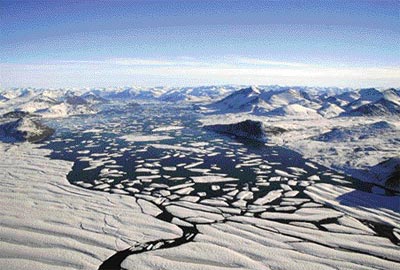
Canadian
Arctic nearly loses entire ice shelf
Two ice shelves that existed before Canada was settled by Europeans
diminished significantly this summer, one nearly disappearing
altogether, Canadian scientists say in newly published research.The loss
is important as a marker of global warming, returning the Canadian
Arctic to conditions that date back thousands of years, scientists say.
Floating icebergs that have broken free as a result pose a risk to
offshore oil facilities and potentially to shipping lanes. The breaking
apart of the ice shelves also reduces the environment that supports
microbial life and changes the look of Canada's coastline.

Luke Copland is an associate professor in the geography department at
the University of Ottawa who co-authored the research published on
Carleton University's website. He said the Serson Ice Shelf shrank from
79.15 square miles (205 square kilometres) to two remnant sections five
years ago, and was further diminished this past summer.
Copland said the shelf went from a 16-square-mile
(42-square-kilometre) floating glacier tongue to 9.65 square miles (25
square kilometres), and the second section from 13.51 square miles (35
square kilometres) to 2 square miles (7 square kilometres), off
Ellesmere Island's northern coastline.
This past summer, Ward Hunt Ice Shelf's central area disintegrated
into drifting ice masses, leaving two separate ice shelves measuring
87.65 and 28.75 square miles (227 and 74 square kilometres)
respectively, reduced from 131.7 square miles (340 square kilometrrs)
the previous year.
"It has dramatically broken apart in two separate areas and there's
nothing in between now but water," said Copland.
Copland said those two losses are significant, especially since the
Ward Hunt Ice Shelf has always been the biggest, the farthest north and
the one scientists thought might have been the most stable.Copland, who
uses satellite imagery and who has conducted field work in the Arctic
every May for the past five years, said since the end of July, pieces
equaling one and a half times the size of Manhattan Island have broken
off. Co-researcher Derek Mueller, an assistant professor at Carleton
University's geography and environmental studies department, said the
loss this past summer equals up to three billion tons. Copland said
their findings have not yet been peer reviewed since the research is
new.
Scambos said the loss of the Arctic shelves is significant because
they are old and their rapid loss underscores the severity of the
warming trend scientists see now relative to past fluctuations such as
the Medieval Warm Period or the warmer times in the pre-Current Era
(B.C.).
Ice shelves, which began forming at least 4,500 years ago, are much
thicker than sea ice, which is typically less than a few feet (meters)
thick and survives up to several years.Canada has the most extensive ice
shelves in the Arctic along the northern coast of Ellesmere Island.
Courtesy: AP |

